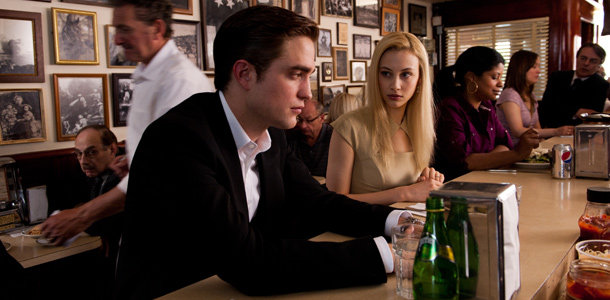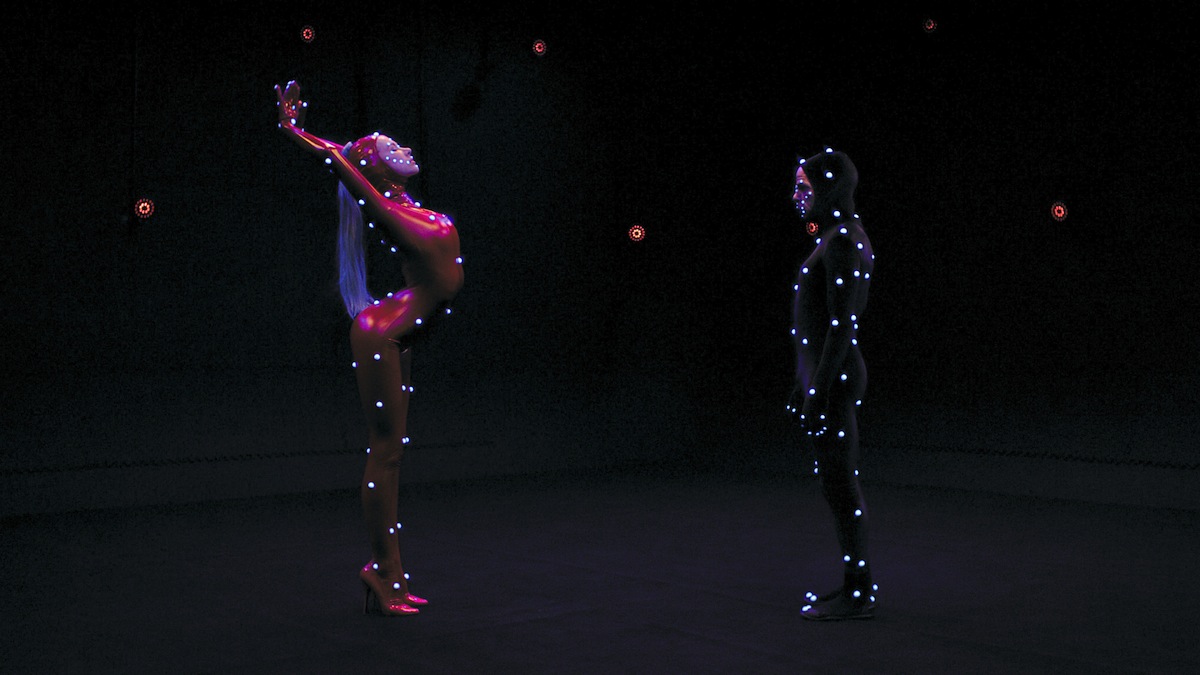With the title's 'unchained' Django (Jamie Foxx) thus joining the flesh-hunting Schultz, the latter coaches his new riding companion on the role he will be charged to fulfill, first in virtual form and consequently in point-of-fact: that of a free man. Waltz's lead insists on the importance of Django not breaking character, and entreats his new associate to select his costuming - an invitation that initially results in an brassy blue suit and over-sized white lace bow that feels borrowed from the visual lexicon of African American minstrelsy. Of course, when Django is compelled, following his archetypal emergence as a New Hollywood cowboy, to pretend that he is a black slaver, "the lowest of the low" - despite his stated reservations, Foxx's character shows some relish in inhabiting the despicable figure - he opts for dark-toned garments and gold-tinted spectacles that help the undercover black bounty hunter to carry off his latest role in true Tarantino fashion, as a bad-ass.
In transitioning between freeman and black-slaver, Tarantino's Django invites the spectator to consider the performed aspect of each historical type. With the film's subsequent sketching of Samuel L. Jackson's kowtowing head house slave Stephen in disparate public and private settings, where he inhabits profoundly different personas, Django Unchained further extends this discourse onto the institution of slavery itself, with the abundant mental aptitude of Jackson's villainous race-trader coming into view. That is, through Jackson's shifting characterization, one that it should be added that cuts strongly against the Gone with the Wind (1939) simpleton stereotype in its acknowledgement of Stephen's substantial masked intelligence, writer-director Tarantino suggests that slavery itself - and as always its depiction over the course of film history - required an adherence to expected type, which belied the personality and again mental abilities of those inhabiting the roles. Tarantino's film opens up a space between the role and the person (rather than the slave) inhabiting it.
Django Unchained's theatrical discourse serves additionally to translate Inglourious Basterds' (2009) Occupation-era cinematic intertext into a self-referential form more appropriate to the film's mid-nineteenth century moment. The incontrovertibly major Inglourious Basterds indeed provides a point of departure in almost every sense, beginning with its ontological status as an object of psychic historical revision: where Inglourious Basterds provides a fantastic, contingent counter-reality in which Jews and members of the cinematic colony bring about the destruction of the Third Reich, in an orgiastic final act explosion of extreme cartoon violence, Django Unchained gives agency to the victims of the Trans-Atlantic slave trade, whether it is the unshackled slaves in the opening set-piece, Django in his role as homicidal bounty-hunter, or the latter in his final, ruthless, John Woo-coded devastation of Candieland (which will include slavers and complicit whites and blacks alike). Django Unchained also responds to and revises Inglourious Basterds' negative Germanic archetype, with former film Nazi Waltz recast as the 'good guy.' At the same time, the World War II film's heroic Americans are now cast as their villainous, slave-owning ancestors in what will prove the first of Django Unchained's many provocations.
Even more inciting perhaps than Django Unchained's audacious anti-Americanism is its approach to its race-centered subject in a purportedly post-racial America. In particular it is Django Unchained's facility for making its spectator take pleasure in one form or another in the focalized Schultz and Django's interactions with the film's execrable Southern subjects, whether it is the humor that he or she finds in Big Daddy's (Don Johnson) sudden, financially prompted acquiescence to Django's visiting freeman; Stephen's hyperbolized embodiment of his house slave role; or the brutal Monsieur Candie's (Leonardo DiCaprio) perverse appreciation of Foxx's black-slaver. In each one of these instances, it is the charisma of the performers, in a further indication of the centrality of the film's performative discourse, along side the character's moral or intellectual flexibility - their humanity, in a manner of speaking - which sanctions the spectators enjoyment.
However, this is not to suggest for a moment that Django Unchained glosses slavery. Indeed, in Tarantino's latest, the viewer is immediately confronted with the nauseating brutality of the institution in the sliced backs of the film's black subjects, the unrepresentable spectacle of dogs ripping a Mandingo fighter to pieces - this off-frame holocaust brings about a change in the German Waltz - and of their dehumanizing denial of family, which in Django Unchained provides the ultimate impetus for the film's cotton-field Odyssey. Django Unchained in this sense is a very moral film, despite its trafficking in an Alfred Hitchcock-inspired amorality and its incursions of extreme visceral violence.
Much more can and should be said for and of Django Unchained, beginning with its exploitation and genre-cinema citations and its admixture of cultural archetypes in the service of its black subject matter. (Of note, for instance, is the provocative appearance of hip-hop to coincide with Django's embodiment of the black-slaver role.) For now and for this writer, let me just close by stating simply that Django Unchained could have been made by no one other than Tarantino and that, for better or (on some socially symptomatic level) worse, the director's latest stands as the most powerful piece of American filmmaking to reach screens in the past twelve months.
Let me thank fellow Tativille contributor Lisa K. Broad for her substantial contributions to this piece, and especially for her insights into the film's theatrical thesis.





